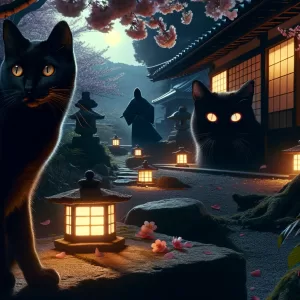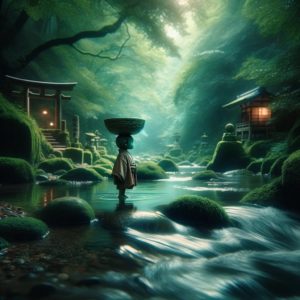The tale of the Vampire Cat of Nabéshima stands as a captivating blend of horror, mystery, and feline allure. This article delves into the haunting legend of Nabéshima’s Vampire Cat, exploring its origins, the cultural context that birthed it, and its enduring presence in the collective imagination.
The Tale’s Beginnings: A Haunting in Feudal Japan
The legend of the Vampire Cat hails from the Edo period in Japan, a time rife with superstition and folklore. It is set in the Hizen Province, where the Nabéshima clan reigned. The story tells of a mysterious cat that, upon the death of a beloved courtesan, transforms into a malevolent entity. This cat, possessed with supernatural powers, begins its reign of terror in the Nabéshima domain.
A Feline Specter: The Vampire Cat’s Transformation
As the legend goes, this cat was no ordinary feline. After the courtesan’s death, whom it dearly loved, the cat transformed at night, taking on the deceased woman’s appearance. By day it remained a cat, but by night, it became a spectral being, haunting the Nabéshima lord and slowly draining his life force. The tale weaves a complex narrative of love, loss, and revenge from beyond the grave, embodied in the form of a vengeful cat.
Cultural Underpinnings: Superstition and Symbolism in Edo Japan
To understand the legend’s resonance, one must delve into the cultural beliefs of Edo-period Japan. Cats were often seen as mystical creatures with dual natures – both protective and malevolent. The Vampire Cat of Nabéshima encapsulates this dichotomy, symbolizing the fine line between the benevolent spirit and the vengeful ghost. It reflects the era’s anxieties about the supernatural and the unknown, especially concerning entities that cross the boundary between life and death.
Artistic Renderings: The Vampire Cat in Ukiyo-e and Literature
The Vampire Cat’s legend has been immortalized in various artistic forms, most notably in Ukiyo-e (Japanese woodblock prints). These prints often depict the cat in its night form, capturing its eerie, otherworldly essence. The tale has also been a popular subject in Japanese literature, retold through generations, each version adding its layer of intrigue and terror.
Enduring Legacy: The Vampire Cat’s Place in Modern Culture
Today, the legend of the Vampire Cat of Nabéshima continues to fascinate and inspire. It appears in modern media, from manga and anime to contemporary literature, often reimagined with new twists. The tale’s enduring appeal lies in its ability to evoke the primal fear of the unknown, combined with the enigmatic nature of cats, creatures that have always danced on the edge of human understanding.
The Eternal Whisper of the Vampire Cat
The legend of Nabéshima’s Vampire Cat is more than just a ghost story; it is a window into the human psyche, exploring our fears and fascinations with the supernatural. It stands as a testament to the power of folklore to endure through time, adapting to the changing landscapes of culture and society. In the shadows of Japanese lore, the whisper of the Vampire Cat continues to echo, a haunting reminder of the mysteries that lie just beyond the veil of the known world.








